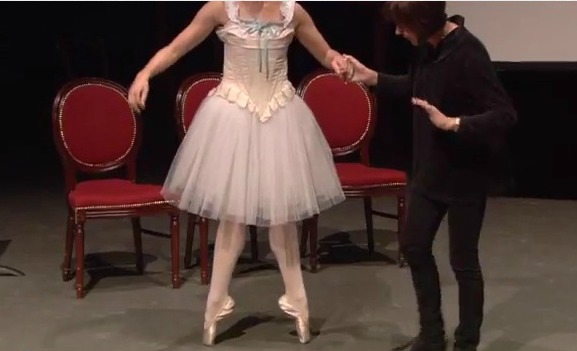The Royal Opera House and the Royal Academy of Arts presented ballet Mistress Ursula Hageli’s analysis of the evolution of classical ballet technique through the paintings of Degas dancers. An excited Ms. Hageli shared her findings with the help of Royal Ballet dancers Leanne Cope and Lauren Cuthbertson; Leanne representing the Degas-style dancer and Lauren the modern day ballerina.
Marie Taglioni was the first ballerina to go on her toes. Toe shoes were still very soft, no block, only darned at the tips. Dancers would only rise on their toes for a brief moment. Back then, ballerinas did not pirouette on their toes as they do today. Taglioni trained with her father who boasted that she was light on her feet and also very chaste. By Degas’ time the length of ballet skirts had shortened to above the calf and had to be used with bloomers.
Any family man could bring their entire family and even at the height of her (Taglioni’s) jumps they would not be able to see her knees.
Hageli adds that dancers also used corsets which limited the range of movement of their torsos as well as their arms, thus their more rounded port de bras and slightly forward-tilted stance.
The evolution of classical ballet technique dates back to Louis XV’s court.
It is in the tradition of classical ballet that technique is passed on directly Enrico Cecchetti having been taught by Giovanni Lepri who was taught by Carlo Blasis and the line can be traced back to Beauchamp the first ballet master at the court of Louis XV. Wikipedia.org
Blasis developed a treatise of ballet movements upon which today’s methodology is based.
Cecchetti taught with much longer exercises than the ones used today, which might be why many of Degas dancers are portrayed resting due to extraneous exertions. Leanne and Lauren demonstrate one of such exercises to the public after which they are asked by Hageli how they felt, to which Leanne responded:
“It’s hard ’cause your working leg becomes your supporting leg…. and that leg is already very tired.”
Insights into the evolution of classical ballet technique as explained by Ms. Ursula are thought-provoking as well as entertaining, as you can see in this video.
To see original video, here.
Here’s the lovely quote Ms. Hageli read by ballet master and choreographer Enrico Ceccheti:
“Aim at softness and ease in your performance of a dance.
Endeavor that all shall be harmonious.
However hard you work at your lessons or at rehearsals,
let none of this effort be visible in your performance.
There must be no sign of concentration, exertion, or tension.
All must be free and natural.
For the true art is that which conceals the labor that produced it.”
I found this didactic class fascinating. Ms. Hageli ties in the paintings of Edgar Degas with fashion, with ballet technique and it’s theory as handed down from Blasis to Cecchetti magnificently, thus the evolution of classical ballet technique.
Did you notice the “oohs” and “ahs” of the attendees as Lauren executed a high extension developpe a la second in minute 8:42? By the audience’s applause you can tell they enjoyed the insights presented by Hageli and the dancers.
Please tell us what you enjoyed the most about the video above and this article. We love getting your feedback. “Like” us too below!



This video on the evolution of ballet technique was delightful. I am most interested in learning more about how that technique and the choreography associated with it has evolved from say from the the 1960’s (when I was a student) to the present. Has there been anything written that speaks to this. I know with the advent of Pilates and other strength building activities the difficulty and skill levels have soared.
Ballet technique has certainly evolved from the 60’s to today. Dancers’ extensions (raising of their legs) have increased, as have the number of pirouettes executed in a given variation, especially for male dancers (Carlos Acosta, for example). Double or triple pirouettes used to amaze us 50 years ago. Now that is the minimum requirement.
In the past we rarely saw danseurs with high extensions or beautifully arched feet – that was mostly considered a ballerina’s domain. Now-a-days we find dancer’s like David Hallberg (Bolshoi) with exquisite feet and incredible over 90º developpés. (See Hallberg´s relevé here: http://classicalballetnews.com/american-dancer-joins-the-bolshoi-ballet/).
Concerning Pilates and other strength training programs, I recommend you read our post: “Zena Rommett’s Floor-Barre® Technique” http://classicalballetnews.com/zena-rommetts-floor-barre-technique-personal-review/
Watch the video: Dana Genshaft, dancer with San Francisco Ballet, talks about her experience with this training method, her comeback after an injury and the effect it had on her technique and career.
Thanks for taking time to comment and sharing your thoughts. I’m glad you enjoyed the video/article!
Sheila Lehner,
I just found your FB group (Page) Benevolent Ballet Fall Prevention for Elders and asked to join. I look forward to learning more from what you’re doing and if I can be of any help, let me know.
-Romy